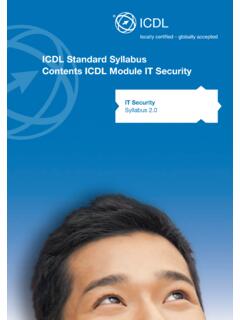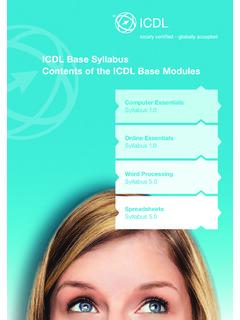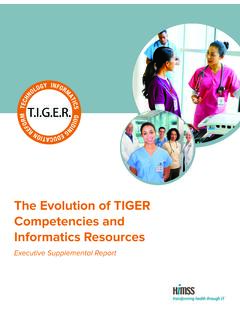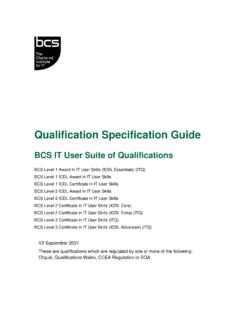Transcription of ICDL Standard Syllabus Contents of the ICDL Standard …
1 icdl Standard Syllabus Contents of the icdl Standard Modules Using Databases Syllabus Presentation Syllabus Online Collaboration Syllabus IT Security Syllabus Image Editing Syllabus Editor PSI Services (Switzerland) Inc. Elisabethenanlage 7. CH-4051 Basle Phone +41 61 270 88 77. Fax +41 61 270 88 76. Copyright 2016 PSI Services (Switzerland) Inc. All rights reserved. This publication may only be used in connection with the ecdl / icdl initiative. Disclaimer PSI Services (Switzerland) Inc. has taken great care in the preparation of this publication, but can give no warranty for the completeness or accuracy of the information contained within it nor shall they be liable for any possible damages arising from this information.
2 In case of doubt the version of the ecdl Foundation published at applies. You can nd the online version of this icdl Syllabus at 2. Contents icdl Standard Modules page Using Databases 6. Syllabus Version . Presentation 10. Syllabus Version . Online Collaboration 15. Syllabus Version . IT Security 20. Syllabus Version . Image Editing 27. Syllabus Version . 3. icdl Standard . prove your extensive digital skills The icdl Standard certi cate proves that you can use a computer competently and ef ciently as well as your extensive practical skills in using common Of ce programmes and further important applications. The ecdl Foundation has created new modules and updated the test Contents according to the latest developments.
3 This icdl Syllabus describes the knowledge you need to pass icdl Standard modules. You can also use this booklet as a checklist to nd out which skills you still need to acquire. To obtain an icdl Standard certi cate you need to pass all four Base modules plus three Standard modules of your choice. The Contents of the icdl Base modules are listed in the icdl Base Syllabus . Most icdl Test Centres offer courses for the icdl modules. You can take the corresponding exams at any one of about 300 icdl Test Centres in Switzerland and the Principality of Liechtenstein, whether you participated in a course there or not. You can get more information on the advanced certi cates, icdl Advanced and icdl Expert, as well as an overview of all icdl Test Centres on Our webshop offers a range of courseware suitable for the preparation for the icdl exams.
4 Julia van Wijnkoop Managing Director PSI Services (Switzerland) Inc. 4. icdl Modules and Certificates Base Modules Standard Modules Advanced Modules computer Using Databases Word Processing Essentials Online Essentials Presentation Spreadsheets Online Word Processing Database Collaboration Spreadsheets IT Security Presentation Image Editing icdl Base Certificate 4 Base modules icdl Standard Certificate 4 Base modules + 3 Standard modules of your choice icdl Advanced Certificate icdl Expert Certificate 1 Advanced module of your choice 3 Advanced modules of your choice 5. Using Databases Using Databases This module requires the candidate to understand the concept of a database and demonstrate competence in using a database.
5 Module Goals Successful candidates will be able to: } Understand what a database is and how it is organized and operated } Create a simple database and view the database content in various modes } Create a table, define and modify fields and their properties; enter and edit data in a table } Sort and filter a table or form; create, modify and run queries to retrieve specific information from a database } Understand what a form is and create a form to enter, modify and delete records and data in records } Create routine reports and prepare outputs ready for distribution Category Knowledge Area Ref. Knowledge Item 1 | Under | Key Concepts Understand what a database is standing Databases Understand the difference between data and information Understand how a database is organized in terms of tables, records and fields Know some of the common uses of large-scale databases like: airline booking systems, government records, bank account records, hospital patient details | Database Understand that each table in a database Organization should contain data related to a single subject Understand that each field in a table should contain only one element of data Understand that field content is associated with an appropriate data type like.
6 Text, number, date/time, yes / no Understand that fields have associated field properties like: field size, format, default value 6. Using Databases Category Knowledge Area Ref. Knowledge Item Understand what a primary key is Understand what an index is. Understand how it allows for faster data access | Relationships Understand that the main purpose of relating tables in a database is to minimize duplication of data Understand that a relationship is built by matching a unique field in one table with a field in another table Understand the importance of maintaining the integrity of relationships between tables | Operation Know that professional databases are designed and created by database specialists Know that data entry.
7 Data maintenance and information retrieval are carried out by users Know that a database administrator provides access to specific data for appropriate users Know that the database administrator is responsible for recovery of a database after a crash or major errors 2 | Using the | Working Open, close a database application Application with Databases Open, close a database Create a new database and save to a location on a drive Display, hide built-in toolbars. Restore, minimize the ribbon Use available Help functions | Common Tasks Open, save and close a table, query, form, report Switch between view modes in a table, query, form, report Delete a table, query, form, report Navigate between records in a table, query, form Sort records in a table, form, query output in ascending, descending numeric, alphabetic order 7.
8 Using Databases Category Knowledge Area Ref. Knowledge Item 3 | Tables | Records Add, delete records in a table Add, modify, delete data in a record | Design Create and name a table and specify fields with their data types like: text, number, date /. time, yes/ no Apply field property settings: field size, number format, date / time format, default value Create a validation rule for number, date / time, currency Understand consequences of changing data types, field properties in a table Set a field as a primary key Index a field (with, without duplicates allowed ). Add a field to an existing table Change width of columns in a table 4 | Retrieving | Main Operations Use the search command for a specific word, Information number, date in a field Apply a filter to a table, form Remove the application of a filter from a table, form | Queries Understand that a query is used to extract and analyse data Create a named single table query using specific search criteria Create a named two-table query using specific search criteria Add criteria to a query using one or more of the following operators: = (Equal), <> ( Not equal to), < ( Less than), (Less than or equal to), > ( Greater than), (Greater than or equal to).
9 Add criteria to a query using one or more of the following logical operators: AND, OR, NOT. Use a wildcard in a query, * or %, ? or _. Edit a query: add, modify, remove criteria 8. Using Databases Category Knowledge Area Ref. Knowledge Item Edit a query: add, remove, move, hide, unhide fields Run a query 5 | Objects | Forms Understand that a form is used to display and maintain records Create and name a form Use a form to insert new records Use a form to delete records Use a form to add, modify, delete data in a record Add, modify text in headers, footers in a form 6 | Outputs | Reports, Understand that a report is used to print Data Export selected information from a table or query Create and name a report based on a table, query Change arrangement of data fields and headings within a report layout Present specific fields in a grouped report by sum, minimum, maximum, average, count, at appropriate break points Add, modify text in headers.
10 Footers in a report Export a table, query output in spreadsheet, text (.txt, .csv ), XML format to a location on a drive | Printing Change the orientation ( portrait, landscape ). of a table, form, query output, report. Change paper size Print a page, selected record(s), complete table Print all records using form layout, specific pages using form layout Print the result of a query Print specific page (s) in a report, print complete report 9. Presentation Presentation This module requires the candidate to demonstrate competence in using presentation software. Module Goals Successful candidates will be able to: } Work with presentations and save them in different file formats } Choose built-in options such as the Help function within the application to enhance productivity } Understand different presentation views and when to use them, choose different slide layouts and designs and edit slides } Enter, edit and format text in presentations.



